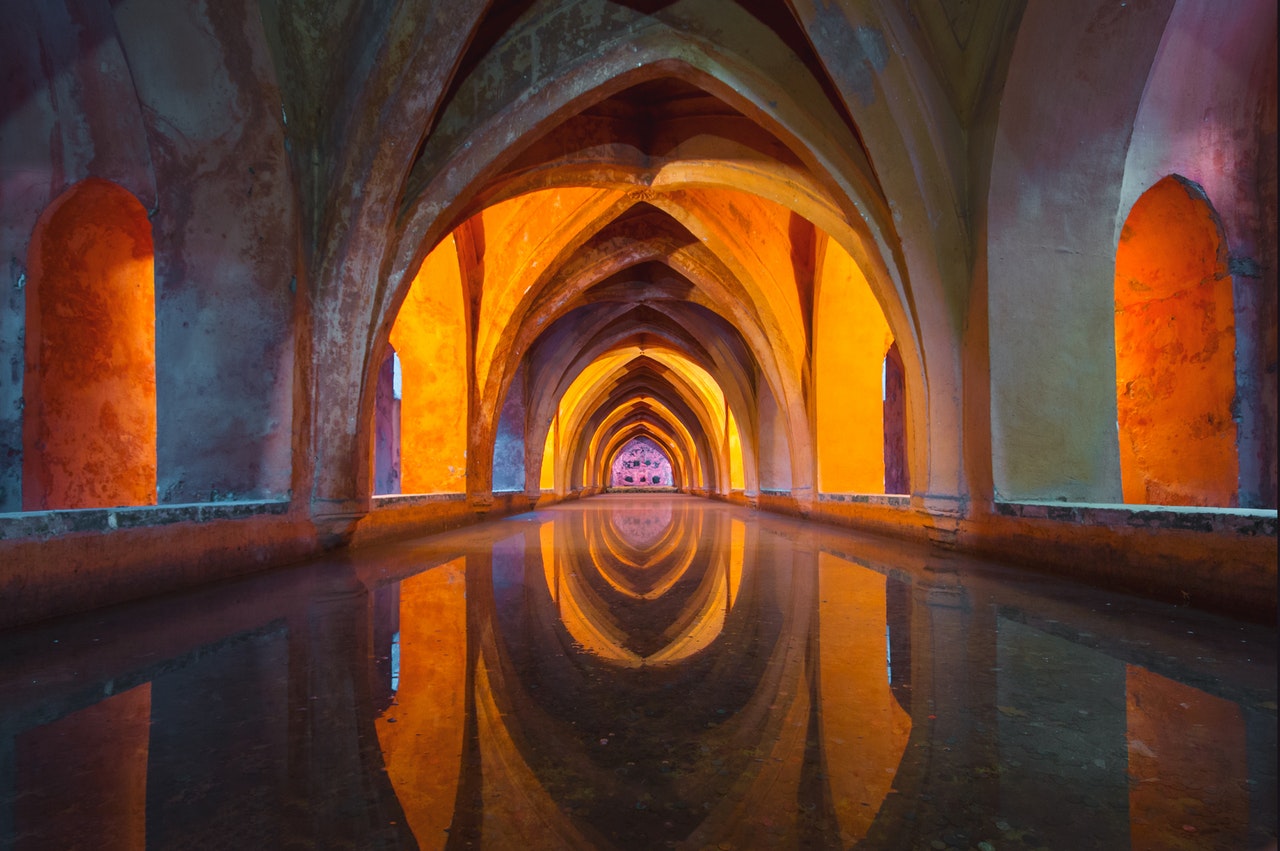Each of us has an inner temple waiting to be built. The inner temple is a spiritual refuge and magickal workspace built at the crossroads of the inner realm and the astral realm, where the individual meets the universal. Like a Klein bottle, if you journey far enough inside yourself, you realize you’ve travelled outside to the universe, and if you continue questing further, you eventually return to your self. The inner temple lives in the space where interior and exterior meet, a gateway between worlds and a fertile land for spiritual development. Building the inner temple is an immersive exercise that will serve your personal practice for years to come.
Everyone has a dream house or a memory of the perfect place to call home. This is often the basis for the inner temple, but the inner temple can take any form that is meaningful to its builder. For a period of time, my inner temple took the form of the interior of the TARDIS from Doctor Who. The gateway to the outer realms was the time rotor, and I would climb up on the console and step into it to ascend to where I wanted to go. Its many doors went many places, both in my mind and out in the world, and the front door was kind of like the house in Howl’s Moving Castle — it opened to wherever I wanted to travel. But my inner temple has for many years been a deceptively small stone house with a walled garden and well, surrounded by mist in a grey, undefined landscape. All of its features, from the plaque on the front door to the grotesques carved into the bluestone of the garden walls, have magickal purposes.
My inner temple didn’t arise fully-formed from the mists. It was built over time and imbued with purpose and significance. I remember during my meditations that I would physically push against walls in my little cottage to move them. At times, it was an act of will to expand my space. Other times, I could just wave my hand and the room would rearrange itself according to my imagination. I remember labeling books and putting them in the bookcase in one room of my temple, charging them with specific knowledge sort of like they were part of a mind palace. When I started out, that bookcase was empty. How it’s almost full, but more empty bookcases have appeared. When I realized I needed a door guardian, one appeared as if he’d always been there, disguised as a harmless bit of furniture but its true form and capabilities known to me. As if have grown, so too has my inner temple grown.
Building the inner temple is an immersive experience of imagination, will, and belief. It’s not a “one and done” event, but rather a personal practice that takes several sessions to create and a lifetime to maintain. Like a house, building it is just one leg of the journey. And like a house, the inner temple needs regular attention or it will fall into clutter and disrepair. I had the disheartening experience of learning this lesson the hard way when, returning to my practice after a secular sabbatical, I found my inner temple’s workroom, with its altar and collection of magickal items, in a jumble as if it had been hastily rummaged through and not put back to rights when whatever I’d been looking for had been found. It was a frustrating exercise in reordering my spiritual life — no one enjoys sorting through junk — but it was a needed and very productive experience as I realized that many of the things I’d held on to were no longer necessary.
Planning The Work
Your inner temple is a reflection of who you are, what you believe, how you practice, and who you want to become. It will grow and change as you grow and change, and it may go through several iterations as you settle into your path and practice. The process of building your inner temple is a cooperative process with your own mind, which is rich with encoded symbols and significant features that you may not realize until you’re actually doing the work of creating or uncovering the space.
One technique I used when I was designing my inner temple, before I even sat down to go into meditation, was to draw it out. You can use pencil and paper or go 3-D and create a diorama or use interior design software to visualize what you know you want out of your space — whatever is going to work to get your creative juices flowing. I used blank pages in my journal to sketch a floor plan for individual rooms then labelled particular parts of the design with note flags. I didn’t worry too much about how the rooms fit together because I wanted to allow some room for my unconscious mind to work. Some rooms were intricately detailed. Other rooms were spartan. And sometimes what I planned and what actually arose in the meditation were different things.
Working The Plan
Once you’ve got an idea of what you’d like your inner temple to look like, it’s time to go into meditation and create or uncover the space. The meditation technique I like to use is inspired by the scene in The Mists of Avalon where Morgaine travels to the Holy Isle for the first time. She’s in the barge, surrounded by grey mist, and everything is enshrouded … and then, the mists lift and Avalon is revealed. Using similar imagery, you can create or uncover your inner temple.
If you’re able to focus for long periods of time, I recommend allowing an hour for this meditation. If focusing for long periods isn’t your strongsuit, it’s possible to do the meditation in a series of small bursts of five to seven minutes. I’ll describe both techniques below.
For the long meditation, start by getting comfortable by sitting in a comfortable chair or on the floor or laying down. Envision yourself sinking comfortably into the support of what you’re sitting or laying on, and as you sink comfortably into it, envision mist enveloping you. See it, or feel it on your skin, or smell the moisture in the air, or know that it’s present. Imagine it getting thicker and thicker until it’s almost opaque. Then arise and start walking. Let the mists part and reveal the path to you, and declare aloud your intent to visit your inner temple. See the mists part before you, revealing the place where your inner temple resides. You may find that there is already some structure there, or you could find a “construction site” with tools and materials waiting for you to work with.
At this point, it’s important to point out that you’re in magickal space. The rules of physics only apply to the extent that you allow them to. So you can lift huge stone blocks with your bare hands. You can create doors that go to faraway places. You can build one room in the same physical space as another room and both of them exist independently of the other. You can create furnishings out of thin air and imbue them with certain capabilities. Let your magickal mind run free with creativity. Explore your space. Learn what is already there, and build what is not already there. Uncover features you hadn’t realized existed. This is a very intuitive process, so go with your gut and listen to your inner voice.
When you find you’re at a stopping point, declare to the space, “Good work. I’ll be back later to continue.” Then lock the door or the front gate or place a protective bubble around your site — something that signifies to you that it is safe from intruders. Sit or lay down and let the mists cover you once more. Remember where you were when you began the meditation and let the mists part to find yourself there once more.
For the short meditation, envision yourself surrounded by mist. Declare aloud your intent to visit your inner temple, and let the mists part to reveal your space. Again, there might be a structure there, or it might be a “construction site”. Give yourself one task to accomplish — look at the details of the front door, explore a single room, put magickal tools in a special place. Once that task is accomplished, declare to the space, “Good work. I’ll be back later.” Then lock the door or the front gate or place a protective bubble around your site, and let the mists surround you again, returning you to ordinary space.
To return to your inner temple, you can use the same walking-through-the-mist meditation, only now you know where you’re going, so the mists can reveal your front door, your front gate, the mouth of the cave, or wherever your entry point is immediately. Explore it thoroughly. Get to know it. Fill it with your magical objects and your knowledge. Make it yours.
Maintaining The Inner Temple
Once your inner temple is created, the ongoing task will be to maintain it. Like a mundane space, it needs regular attention in order to be useful. The main way you can do this is by using the space during meditation. By working in the inner temple during your meditations, or by doing “virtual rituals” in your inner temple rather than at your physical altar, you empower the space and give it the opportunity to work cooperatively with you. I’ve found that working in my inner temple gives me “advance warning” about a lot of things — in the form of general feelings when I’m in a certain area, or objects appearing or disappearing or changing places, or weather patterns, or visitors lingering outside my front gate, or new entries written in the guestbook in the entryway, or letters and parcels in my mailbox. These warnings give me the opportunity to address issues with my health, my magical projects, my connections with others, and my safety.
From time to time, you may feel the need to add or change rooms or features in your inner temple. Do it! This is your little house in the mists, sitting at the crossroads of the world inside and the world outside. Make it yours and let it grow with you.
If working with the inner temple sounds like something you’d like to add to your personal practice, then get out your notebook and start listing features you’d like to incorporate. Let your imagination run wild! Then get creative and experiment with elevations and floor plans and see what you might want it to look like. The enthusiasm you bring to designing your space will empower it and help bring your inner temple to life.

